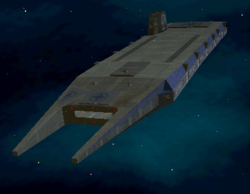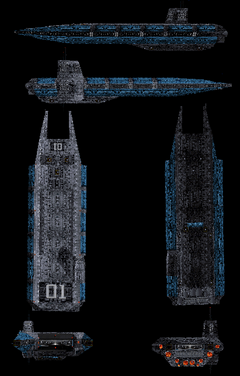Vesuvius-class heavy carrier
| Vesuvius | |
|---|---|

| |
| Type | Heavy Carrier |
| Manufacturer | Orion Station Shipyards |
| Primary User | Terran Confederation |
| Introduction | 2673 |
| General Characteristics | |
| Length | 1,600 meters |
| Mass | 250,000 tonnes |
| Crew | 7,800 |
| Spacecraft Carried | Four Fighter Wings |
| Performance | |
| Acceleration | good k/s2 |
| Velocity | |
| Cruise | 100 kps |
| Maximum | 150 kps |
| Armament | |
| Turrets | |
| Dual Mount Anti-matter Guns (16) Dual Mount Laser Turrets (24) Dual Mount Mass Driver Turrets (16) Torpedo Tubes (2) | |
| Components | |
| Decoys | No |
| Jump Drive | Yes |
| Defense | |
| Armor | |
| Rear | 4000 cm |
| Right | 4000 cm |
| Left | 4000 cm |
| Core Damage Points | 6000 |
The Vesuvius-class of fleet carrier entered service with the Terran Confederation Navy in 2673, during the midst of the Border Worlds Conflict. Designed during the closing decade of the Terran-Kilrathi War as the ultimate fleet carrier, construction on the vessels began too late for them to see service during the conflict. In the time since its introduction, the class has formed the backbone of a smaller but still capable Confederation Navy, replacing older fleet carriers as they are retired. With its heavy armament, armor and shielding, and a complement of 400 fighters, the Vesuvius is one of the most formidable capital ships currently in service. The class has been witness to many campaigns during its service life, from its genesis during the clash with the Border Worlds to service in the Nephilim war.
Design and Construction
The Vesuvius-class is the culmination of forty years of shipbuilding knowledge and technology developed during the Kilrathi war. Many of its design features were Terran takes on concepts originally introduced by the Kilrathi. These included redundant hangar decks and heavy outer armor, both of which were key design features on the Hakaga class of Kilrathi super-carriers which attacked Earth in 2668. At 1600 meters in length and 250,000 tonnes, Vesuvius is almost three times as massive as the next largest Confederation capital ship, the Confederation-class dreadnought. With a primary armament of 16 dual mount anti-matter guns and forty point defense turrets, the Vesuvius class is more than a match for opposing capital ships. 7,800 crew are required to operate the ship and its fighter wings. With deck space and repair facilities to house 400 fighters, the class carries four times the number of fighters of a conventional fleet carrier. Her top speed of 150 kps and maneuverability ratings of 6 dps on all axis also make the Vesuvius class exceptionally maneuverable for ships of their size. The massive dimensions of these ships prohibit them from using certain jump points which do not have the energy to allow large ships to make a jump transit.
The first two ships of the class, Vesuvius and Mount St. Helens were constructed at the Confederation Shipbuilding Facility at Orion Station. Too large for the existing construction yards at the time they were laid down, the carrier's hulls were constructed by massive foundry ships. Once their hulls finished principal construction, the ships were moved to construction docks at Jupiter Station, where their final fitting out was completed. As larger shipbuilding facilities were completed, the remaining units of the class were constructed in a more conventional environment.
Service History
The class' entry into service was turbulent. Vesuvius was commissioned and launched in 2673, right as the conflict in the Border Worlds was intensifying. Admiral Geoffrey Tolwyn, under the guise of his position as head of the Strategic Readiness Agency, commandeered Vesuvius for his own personal use immediately after her launch. Vesuvius was used by Black Lance forces as a mobile base during their attempt to incite war with the newly formed Union of Border Worlds. The class leader was destroyed within a month of her launching by a combined force from BWS Intrepid and her own sister ship St. Helens under the command of Captain William Eisen, which had been rushed out of the dock early to assist Intrepid. St. Helens took heavy damage in the engagement and had to return to dock for repairs before she could properly enter service.
Despite its ignoble entry into service, the Vesuvius-class distinguished itself during the Nephilim Conflict. The TCS Eisen transferred her squadrons of Vampires and Devastators to TCS Midway during the opening stages of conflict, and then proceeded to perform her own series of operations as the Nephilim continued to move ships into the Kilrah Sector. The Vesuvius-class carrier TCS McKinley was present during Midway's return to the Sol System after the first Nephilim engagements in Kilrah Sector, and St. Helens was destroyed in a surprise Nephilim attack shortly after the second Nephilim wormhole gate in Proxima was discovered. As more Midway-class carriers came into service, the Vesuvius-class continued to occupy the heavy strike role, complementing the multi-functional, but less powerful, Midway class vessels. Late in the Nephilim War, TCS Krakatoa was instrumental in the defense of the Corsair system, helping to defend the Firekkans and rescuing the crew of the scuttled Midway-class TCS Port Broughton in 2694.
Specifications
| WC4 (Vesuvius) | WC4 (Mount St. Helens) | WCSO | Lore | |
|---|---|---|---|---|
| Length | 1,600 meters | 1,600 meters | 1,600 meters | 1,600 meters |
| Mass | 250,000 tonnes | 250,000 tonnes | 250,000 tonnes | 250,000 tonnes |
| Class | Heavy Carrier | Heavy Carrier | Heavy Carrier | Heavy Carrier |
| Shield Recharge | 1000 cm/sec | 1000 cm/sec | ||
| Maximum Speed | 150 kps | 140 kps | 150 kps | |
| Cruise Speed | ||||
| Acceleration Rate | 10 k/s^2 | 10 k/s^2 | 10 k/s^2 | 10 k/s^2 |
| Yaw Rate | 5 dps | 5 dps | 5 dps | 5 dps |
| Pitch Rate | 5 dps | 5 dps | 5 dps | 5 dps |
| Roll Rate | 5 dps | 5 dps | 5 dps | 5 dps |
| Guns | ||||
| Missiles | ||||
| Torpedoes | ||||
| Turret | Dual Mount Heavy Laser Turret (13) | Dual Mount Heavy Laser Turret (13) | Dual Mount Heavy Laser Turret (13) | |
| Front Shield | 1,000 cm | 1,000 cm | ||
| Rear Shield | 1,000 cm | 1,000 cm | ||
| Front Armor | 500 cm | 500 cm | ||
| Rear Armor | 500 cm | 500 cm | ||
| Left Armor | 500 cm | 500 cm | ||
| Right Armor | 500 cm | 500 cm | ||
| Core | 1,953.128906 cm | 58.593750 cm | ||
| Jump Capable | Yes | Yes | Yes | Yes |
Interior
Bridge
Known Ships
- TCS Vesuvius (CV-70) - Destroyed
- TCS Mount St. Helens (CV-71) - Destroyed
- TCS William Eisen (CV-74)
- TCS McKinley
- TCS Krakatoa
Possible Construction
- TCS Fuji
- TCS Kilauea
- TCS Rainier































